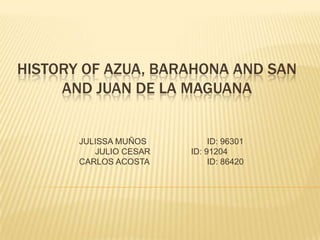History of azua, barahona and san and
- 1. HISTORY OF AZUA, BARAHONA AND SAN AND JUAN DE LA MAGUANA JULISSA MU?OS ID: 96301 JULIO CESAR ID: 91204 CARLOS ACOSTA ID: 86420
- 2. HISTORY OF AZUA TO FIND OUT THE IMPORTANT HERO THAT PLACE HISTORY OF AZUA TO KNOW THE ORIGEN OF NANE AZUA TO BE AWERE OF THE IMPORTANT BATTLE IN THAT PLACE
- 3. AZUA DE COMPOSTELA ? Upon arrival of the Spanish to the island of Santo Domingo , Azua was a nitainato belonging to Maguana Chiefdom (one of the five kingdoms into which the island was divided) Cuyocagua nita¨ªno governed by and under the jurisdiction of Chief Caonabo . ? The Spanish town of Compostela Azua , today called Azua, was founded in 1504 by the advance Diego Vel¨¢zquez de Cu¨¦llar , who would later become the conqueror of Cuba, during the government of Don Nicolas de Ovando , near an estate belonging Don Pedro Gallego, Spanish settled in the area near the nitainato, from the city of Santiago de Compostela , in the region of Galicia . This landowner received at home to Diego Velazquez de Cuellar and his entourage on their way to the south of the island, as they prepared to visit the chieftainship of Jaragua , ruled by Queen Anacaona . According DRAE a nita¨ªno, among the Indians Taino is a person of nobility.
- 4. ? By royal decree of December 7, 1508, given in Sevilla by King Ferdinand the Catholic , the Compostela Azua is granted its coat of arms, having prospered prosecutors proposal Nicuesa Diego and the bachelor Antonio Serrano , and with the full support of Governor Nicolas de Ovando . BATTLE IMPORTANT ? BATLLE OF MARCH 19TH The Battle of Azua was the first major battle in defense of Dominican independence and was fought on March 19, 1844, in Azua. A force of 2,200 Dominican troops, a portion of the southern army, led by General Pedro Santana, defeated a force of 10,000 soldiers of the Haitian army led by General Souffrand.
- 6. HISTORY OF BARAHONA TO FIND OUT THE IMPORTANT HERO THAT PLACE HISTORY OF BARAHONA TO KNOW THE ORIGEN OF NANE BARAHONA TO BE AWERE OF THE IMPORTANT BATTLE IN THAT PLACE
- 7. BARAHONA ? Barahona is one of the 31 provinces of the Dominican Republic located in the southwest of the country, is part of the Region Enriquillo, along with the provinces of Bahoruco , Independencia and Pedernales . ? Bordered on the west by the province Bahoruco , northeast to Azua , Barahona southeast to the west with Independence , south and southwest Pedernales and East has the Caribbean Sea . The provincial capital is the city of Santa Cruz de Barahona . ? Before the discovery and colonization by the Spanish, the Spanish island was divided into five chiefdoms, one of which, Jaragua, who ruled Bohech¨ªo belonged demarcation which houses Barahona.
- 8. BARAHONA ? Around the origin of the name of Barahona were unproved conjectures and hypotheses formulated. ? Some point that comes from Rodand Ona and other Bahia Honda. The first term, it is said, was used by the Spanish to measure species and the second to refer to Neyba Bay, where the population is located. ? Barahona is a Spanish surname, (Barahona is a Basque surname composed of the words bara (tree, mountain) and one (good)), and so is found in Barahona development history. The Spanish spread throughout the country and named objects and places named after them. Francisco Barahona, Barahona Gabriel, Juan Luis Barahona Barahona and arrived in the first and second of Christopher Columbus travel. ? The reference work maintains that Barahona is a surname found in Spanish who came to the island after its discovery in 1492 . A Spanish descent nita¨ªno was Juan Barahona, settler ally Francisco Roldan rebels who revolted in the chiefdom of Jaragua, covering the physical space in which today are located in the province of Barahona, and much of the region South West
- 9. HISTORY OF SAN JUAN DE LA MAGUANA
- 10. HISTORY OF SAN JUAN DE LA MAGUANA
- 11. SAN JUAN DE LA MAGUANA ? At the time of discovery , the region of San Juan was one of five chiefdoms Taino that divided the island of Quisqueya . The Maguana or Maguan¨® chiefdom, with center near the present capital, in John Herrera, was ruled by the chief Caonabo. In 1503 Nicolas de Ovando founded the city of San Juan de Maguana, in honor of San Juan Bautista in 1508 is given by royal decree the title of town with his coat of arms. In 1605 , following the removal of populations and devastation faced by the governor of Santo Domingo, Antonio de Osorio , the people of San Juan come to occupy Bayaguana , north of Santo Domingo , along with the rest of the Spanish uprooted from unpopulated areas. ? Grand Chief Caonabo Maguana King, from Rio Haina to the Artibonite and covering in his Kingdom of the Cibao, is the first to have a primitive conception of a great nation made up of villages united in provinces under a unified leadership. The destruction of the "strong Christmas" in 1493 to stop the outrages of the Spanish against indigenous women is a test of this plan, to which is added the entire war of resistance to colonization defend its "sovereignty."
- 12. IMPORTANT HERO CAONABO JOSE MARIA CABRAL
- 13. OLIBORIO MATERO ¡°PAPA LIBORIO¡± FRANCISCO ALBERTO CAAMA?O DE?O
- 14. IMPORTANT PERSONS HE IS OUR PRESIDENT AND DE FIRST OF SAN JUAN DE LA MAGUANA















